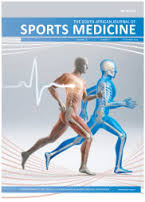The cycle ergometer test is not a reliable alternative to the countermovement jump in the assessment of power output
DOI:
https://doi.org/10.17159/2078-516X/2022/v34i1a12869Abstract
Background: Rugby union is a physically demanding collision sport that requires optimal neuromuscular function
for maximal power output, with mechanical power an integral component of performance. Peak power (Pp) and
relative Pp are parameters of neuromuscular function commonly assessed through the countermovement jump
(CMJ) as a measure of fatigue. The Wattbike cycle ergometer test (CET) is a non-load bearing method of evaluating lower limb power. The cost-effective CET could therefore offer a viable alternative to the CMJ.
Objectives: This study aimed to determine the concurrent validity of the CMJ and CET.
Methods: Thirty-eight professional rugby union players performed twelve CMJs on a force platform with four loads
(bodyweight: BW-CMJ; 20kg: 20-CMJ; 40kg: 40-CMJ and 60kg: 60-CMJ) and a six second peak power (6PPO) CET assessment on a Wattbike ergometer.
Results: CMJ power outputs were [BW-CMJ: Pp - 3101±648 W; 20-CMJ: Pp - 2724±513 W; 40-CMJ: Pp - 2490±496 W; 60-CMJ: Pp - 2238±366 W] and CET [Pp – 1310±161 W]. None of the CMJ-Pp values showed relationships with any CET power variables. Large (r = 0.51-0.63; p = 0.000 – 0.001) relationships
were found to be between relative CMJ and relative CET power outputs. Bland-Altman plots, which were used to
determine the level of agreement between the two assessments, showed the agreement between the tests was
poor.
Conclusion: Though positive relationships existed between relative CMJ and relative CET power variables, analyses of the level of agreement in the Bland-Altman plots suggest that the two power assessment methods are not interchangeable measures of power.
Downloads
Downloads
Published
Issue
Section
License
Copyright (c) 2022 South African Journal of Sports Medicine

This work is licensed under a Creative Commons Attribution 4.0 International License.
The South African Journal of Sports Medicine reserves copyright of the material published. The work is licensed under a Creative Commons Attribution 4.0 (CC BY 4.0) International License. Material submitted for publication in the South African Journal of Sports Medicine is accepted provided it has not been published elsewhere. The South African Journal of Sports Medicine does not hold itself responsible for statements made by the authors.
How to Cite
- Abstract 554
- PDF 547






.png)